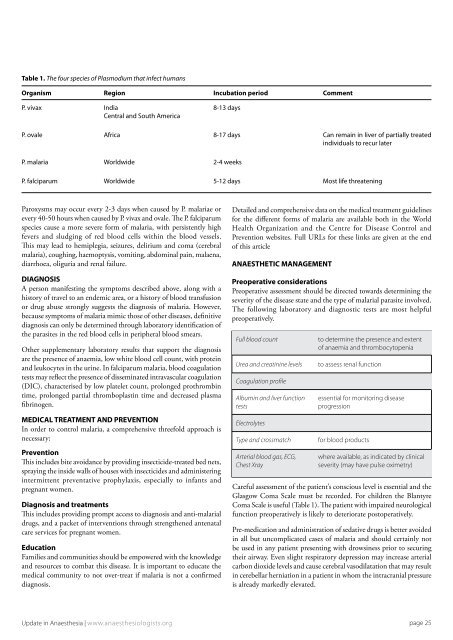Surgically placed rectus sheath catheters - The Global Regional ...
Surgically placed rectus sheath catheters - The Global Regional ...
Surgically placed rectus sheath catheters - The Global Regional ...
Create successful ePaper yourself
Turn your PDF publications into a flip-book with our unique Google optimized e-Paper software.
Table 1. <strong>The</strong> four species of Plasmodium that infect humans<br />
Organism Region Incubation period Comment<br />
P. vivax India 8-13 days<br />
Central and South America<br />
P. ovale Africa 8-17 days Can remain in liver of partially treated<br />
individuals to recur later<br />
P. malaria Worldwide 2-4 weeks<br />
P. falciparum Worldwide 5-12 days Most life threatening<br />
Paroxysms may occur every 2-3 days when caused by P. malariae or<br />
every 40-50 hours when caused by P. vivax and ovale. <strong>The</strong> P. falciparum<br />
species cause a more severe form of malaria, with persistently high<br />
fevers and sludging of red blood cells within the blood vessels.<br />
This may lead to hemiplegia, seizures, delirium and coma (cerebral<br />
malaria), coughing, haemoptysis, vomiting, abdominal pain, malaena,<br />
diarrhoea, oliguria and renal failure.<br />
DIAGNOSIS<br />
A person manifesting the symptoms described above, along with a<br />
history of travel to an endemic area, or a history of blood transfusion<br />
or drug abuse strongly suggests the diagnosis of malaria. However,<br />
because symptoms of malaria mimic those of other diseases, definitive<br />
diagnosis can only be determined through laboratory identification of<br />
the parasites in the red blood cells in peripheral blood smears.<br />
Other supplementary laboratory results that support the diagnosis<br />
are the presence of anaemia, low white blood cell count, with protein<br />
and leukocytes in the urine. In falciparum malaria, blood coagulation<br />
tests may reflect the presence of disseminated intravascular coagulation<br />
(DIC), characterised by low platelet count, prolonged prothrombin<br />
time, prolonged partial thromboplastin time and decreased plasma<br />
fibrinogen.<br />
MEDICAL TREATMENT AND PREVENTION<br />
In order to control malaria, a comprehensive threefold approach is<br />
necessary:<br />
Prevention<br />
This includes bite avoidance by providing insecticide-treated bed nets,<br />
spraying the inside walls of houses with insecticides and administering<br />
intermittent preventative prophylaxis, especially to infants and<br />
pregnant women.<br />
Diagnosis and treatments<br />
This includes providing prompt access to diagnosis and anti-malarial<br />
drugs, and a packet of interventions through strengthened antenatal<br />
care services for pregnant women.<br />
Education<br />
Families and communities should be empowered with the knowledge<br />
and resources to combat this disease. It is important to educate the<br />
medical community to not over-treat if malaria is not a confirmed<br />
diagnosis.<br />
Detailed and comprehensive data on the medical treatment guidelines<br />
for the different forms of malaria are available both in the World<br />
Health Organization and the Centre for Disease Control and<br />
Prevention websites. Full URLs for these links are given at the end<br />
of this article<br />
ANAESTHETIC MANAGEMENT<br />
Preoperative considerations<br />
Preoperative assessment should be directed towards determining the<br />
severity of the disease state and the type of malarial parasite involved.<br />
<strong>The</strong> following laboratory and diagnostic tests are most helpful<br />
preoperatively.<br />
Full blood count<br />
Urea and creatinine levels<br />
Coagulation profile<br />
Albumin and liver function<br />
tests<br />
Electrolytes<br />
Type and crossmatch<br />
Arterial blood gas, ECG,<br />
Chest Xray<br />
to determine the presence and extent<br />
of anaemia and thrombocytopenia<br />
to assess renal function<br />
essential for monitoring disease<br />
progression<br />
for blood products<br />
where available, as indicated by clinical<br />
severity (may have pulse oximetry)<br />
Careful assessment of the patient’s conscious level is essential and the<br />
Glasgow Coma Scale must be recorded. For children the Blantyre<br />
Coma Scale is useful (Table 1). <strong>The</strong> patient with impaired neurological<br />
function preoperatively is likely to deteriorate postoperatively.<br />
Pre-medication and administration of sedative drugs is better avoided<br />
in all but uncomplicated cases of malaria and should certainly not<br />
be used in any patient presenting with drowsiness prior to securing<br />
their airway. Even slight respiratory depression may increase arterial<br />
carbon dioxide levels and cause cerebral vasodilatation that may result<br />
in cerebellar herniation in a patient in whom the intracranial pressure<br />
is already markedly elevated.<br />
Update in Anaesthesia | www.anaesthesiologists.org<br />
page 25
















